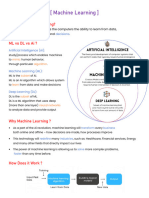0% found this document useful (0 votes)
26 views3 pagesMachine Learning Viva Guide
The document is a comprehensive guide on machine learning, covering key concepts in supervised and unsupervised learning, model evaluation, and advanced techniques. It discusses various algorithms such as KNN, decision trees, and deep learning, as well as recent trends like transfer learning and explainable AI. Important concepts like bias, variance, underfitting, and overfitting are also highlighted.
Uploaded by
akashmaju04Copyright
© © All Rights Reserved
We take content rights seriously. If you suspect this is your content, claim it here.
Available Formats
Download as DOCX, PDF, TXT or read online on Scribd
0% found this document useful (0 votes)
26 views3 pagesMachine Learning Viva Guide
The document is a comprehensive guide on machine learning, covering key concepts in supervised and unsupervised learning, model evaluation, and advanced techniques. It discusses various algorithms such as KNN, decision trees, and deep learning, as well as recent trends like transfer learning and explainable AI. Important concepts like bias, variance, underfitting, and overfitting are also highlighted.
Uploaded by
akashmaju04Copyright
© © All Rights Reserved
We take content rights seriously. If you suspect this is your content, claim it here.
Available Formats
Download as DOCX, PDF, TXT or read online on Scribd
/ 3























































































